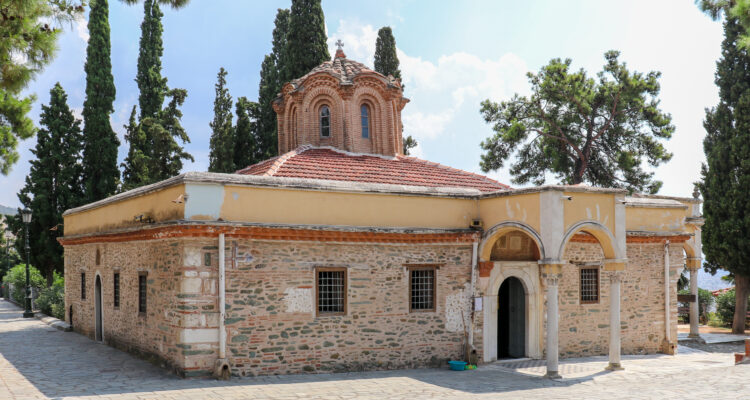The Monastery of Vlatadon, or Vlataion, is a Stauropegial Monastery in the area of the Upper Town of Thessaloniki, approximately 80 meters from the walls of Eptapyrgio. It is the only monastery from the Byzantine period in the city that is still functioning today.
The Vlatadon Monastery is located at an altitude of approximately 120 meters and overlooks the city of Thessaloniki.
Empress Anna Palaiologina, who had settled in Thessaloniki in 1351 and remained in the city as governor until the end of her life, is said to be the founder of the Monastery. The patriarchal Sigillion was issued a little later by the Ecumenical Patriarch Nilos.
After 1387 and the first occupation of Thessaloniki by the Ottomans, the Katholicon was turned into a mosque, as seen from some buildings having Ottoman architecture. After the second conquest of the city in 1430 by the Ottomans, it was allowed to function normally as a monastery and during this period it was called Tsaus Monastery. The locals call the Vlatadon Monastery Tsaous Monastery till today.
It experienced great prosperity as it was given some privileges, which were ratified by a firman of Mohammed II in 1446. According to a tradition of the 16th century, this privileged treatment was due to the help that its monks had offered to the Turks for the capture of the city. In 1633, with the seal of Patriarch Kirillos Lukari, the Vlatades Monastery was annexed as a share to the Monastery of Ivira of Mount Athos.
In 1801 the Katholicon of the monastery was renovated, but in 1870 a fire destroyed part of it, including the library. The damage was repaired at the expense of the Ecumenical Patriarchate.
According to local tradition, the birthplace of the founders of the Holy Monastery of Vlatades is Ligres, a ruined and uninhabited hamlet on the southern (Libyan) coast of the said province in Crete.
The same local tradition speaks of a family with the surname “Vlattas”, which, after a pirate raid, that caused the destruction of the village in question, fled to Thessaloniki. Descendants of this family founded the Holy Monastery of Vlatades.
The founders are the brothers Dorotheos and Markos Vlattis, Dorotheos was a Metropolitan of Thessaloniki and Markos was a well-known hymn writer of the Church, who were students and fellow competitors of Saint Gregory Palamas, Metropolitan of Thessaloniki. G. Theocharidis managed to bring the names of the two brothers back from the past and make them more widely known with a fascinating study.
According to the reliable testimony of Patriarch Philotheus Kokkinos, the Vlattades brothers should have been born in Thessaloniki, but of Cretan parents. However, no one mentions the fact that the Vlatades came from the small village of Ligres in the prefecture of Rethymnon. However, this is confirmed by the existing tradition and the confirmed original origin of the Cretan surname “Vlattas” from the Ligres region of Rethymno.
The monastery’s Katholikon which is preserved has been radically different from the one originally built in the first half of the 14th century. Only the sanctuary and a few other architectural elements remain from the original building. The southern gallery of the temple and the small propylon of the western entrance were built in 1907, in a neoclassical style.
Today, the Monastery belongs to the Ecumenical Patriarchate. Near the monastery’s Katholicon is a vaulted chapel of the 14th century with frescoes from the Paleologan era. According to local tradition, the Monastery was built on the place where the Apostle Paul preached or lived during his stay in the city. 93 codices and the archive of the Monastery are preserved, which, during the Second World War, were transferred for safety to the Monastery of Ivira.
Copyright 2023 © Created By Diadyktio, All Rights Reserved.
To provide the best experiences, we and our partners use technologies like cookies to store and/or access device information. Consenting to these technologies will allow us and our partners to process personal data such as browsing behavior or unique IDs on this site and show (non-) personalized ads. Not consenting or withdrawing consent, may adversely affect certain features and functions.
Click below to consent to the above or make granular choices. Your choices will be applied to this site only. You can change your settings at any time, including withdrawing your consent, by using the toggles on the Cookie Policy, or by clicking on the manage consent button at the bottom of the screen.

Congratulation!